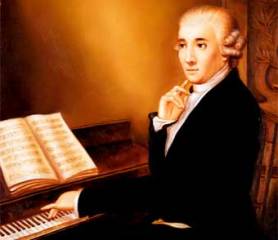Haydn - Symphony No 95 in C minor · Missa in tempore belli in C
Haydn - Symphony No 95 in C minor · Missa in tempore belli in C (Paukenmesse)

1. Applause
2. Harnoncourt speaks about The Missa in Tempore Belli
Missa in tempore belli in C
3. Kyrie Eleison
4. Gloria 1 – Gloria in excelsis Deo play
5. Gloria 2 - Qui tollis peccata mundi
6. Gloria 3 – Quoniam solus Sanctus
7. Credo 1 – Credo in unum deum
8. Sanctus – Benedictus
9. Agnus Dei
Symphony No 95 in C minor
10. I. Andante moderato
11. II. Andante
12. III. Menuetto – Trio play
13. Finale. Vivace
Genia Kuhmeier (soprano),
Barbara Holzl (contralto),
Herbert Lippert (tenor),
Timothy Sharp (bass),
Arnold Schoenberg Choir,
Concentus Musicus, Vienna
Nikolaus Harnoncourt. – director
BBC Radio 3 Listeners, EBU Haydn Day
Sunday 31st May 2009
In 1795, Paul Anton Esterházy's successor, Nikolaus II, decided to reform the Esterházy orchestra. In the process, he invited Haydn back to serve as active Kapellmeister -- rejuvenating the purely nominal post the composer had held for the previous five years. Compared to his previous 30 years of service to the family, Haydn's new duties were still minimal, but they included the annual composition of a mass to celebrate the name day of Princess Josepha Maria in Eisenstadt, forty kilometers south of Vienna.
On the first page of his autograph manuscript of the C major mass, Haydn wrote, "Missa in tempore belli" (Mass in time of war). At the time, Austria was engulfed in a war with the French, and Napoleon was advancing from victory to victory unchecked. In August 1796, precisely when Haydn was at work on the C major mass, the Austrian government issued an order for general mobilization. Some writers have suggested that the baleful timpani part in the Agnus Dei reflects Haydn's reaction to the escalating military conflict; these timpani passages inspired the work's nickname, "Paukenmesse" (Timpani Mass). The Mass in C major is scored for soprano, alto, tenor, and bass soloists, a four-voice mixed choir and a large orchestra with paired woodwinds, trumpets and continuo (organ). Different recordings may feature varied instrumentation during some parts of the mass, as there exist two versions.
London concert promoter Johann Peter Salomon was in Cologne when he heard of the death of Nikolaus Esterházy I, in September 1790, and immediately went to Vienna to secure Haydn for his concerts. Several unsuccessful attempts had been made in the 1780s to entice Haydn to visit England. Now freed from thirty years of service to the Esterházy family, the composer was ready. The first of Haydn's two excursions to London began in December of 1790 and was, by all accounts, a great success. He remained in London for two concert seasons, returning to Vienna in July 1792. The composer wrote six new symphonies for the concert series (now numbered 93-98), the first six of the so-called "London" symphonies.
Composed in 1791, this symphony was first performed near the end of Salomon's 1791 concert season in London, probably in May or June. There is evidence Haydn initially paired the Symphony No. 95 as with the D major symphony, No. 96. It is unique among the "London" symphonies in its lack of a slow introduction and its minor key. Haydn may have felt the dramatic nature of C minor made a slow introduction unnecessary. It is also his only minor key symphony that includes trumpets and timpani.
download: uploaded anonfiles yandex 4shared solidfiles mediafire mega filecloudio nornar
Last Updated (Thursday, 26 December 2013 21:09)








